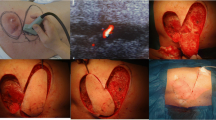Abstract
Part of the conceptual thinking that characterizes reconstructive surgery is to consider the way tissue is transferred: locally pedicled, pedicled from a distance, or free. In 1917, now 100 years ago, the concept of the distant tubed pedicle skin flap was published. The tubed flap has raised a debate about priority in the past. This historical review elucidates this debate and identifies Filatov from Odessa, Ukraine, as the originator of the procedure. Ganzer in Germany published a little later, independently from Filatov, about tubing, while Gillies in England, not knowing the work of either, started to use pedicled flaps at the end of 1917, which primeur was contested by his colleague Aymard. Tubing a pedicle was the final refinement of the distantly pedicled flap. The high volume of facial wounds during the First World War gave army surgeons like Ganzer and Gillies the opportunity to gain experience with all kinds of tubed pedicled flaps. This resulted in a real impetus of reconstructive surgery in the interbellum. This made the tubed pedicle flap the main reconstructive method for large skin defects until the 1970s of the last century, when pedicled myocutaneous flaps and free flap surgery were introduced. There is still a modest place for tubed pedicled flaps in reconstructive surgery. Tubed groin flaps are still useful to cover hand defects and tubed deltopectoral flaps are still used for facial reconstruction in hospitals in less-privileged countries where free flap surgery is not feasible.
Level of Evidence: Not ratable.





Similar content being viewed by others
References
Marck KW, Martin D (2016) Jean-Louis-Paul Denucé (1824-1889): un pionnier oublié de la chirurgie plastique. Ann Chir Plast Esth 61:55–59
Freshwater MF (2015) Joseph Constantine Carpue and the bicentennial of the birth of modern plastic surgery. Aesthet Surg J 35:748–758
von Hacker V (1888) Über den Ersatz grösserer Hautdefecte durch Transplantation frischer ein- und doppelseitiger Lappen aus entfernteren Körpertheilen. Archiv für klinische Chirurgie 37:91–105
Halsted WS (1896) Three cases of plastic surgery. John Hopkins Hospital Journal VII 58:25–26
Dieffenbach JF (1845) Die operative Chirurgie. FA Brockhaus, Leipzig Vol. I, pp 380-89
von Szymanowski J (1870) Lehrbuch der operativen Chirurgie. Erster Theil. Friedriech Vieweg und Sohn, Braunschweig pp 160, 166
Aymard FL (1917) Nasal reconstruction with a note on nature’s plastic surgery. Lancet 190(4920):888–891
Filatov VP (1917) Plastic procedure using a round pedicle (title translated). Vestnik Oftalmologii 34:149–128, in: McDowell F (1977) The source book of plastic surgery. Baltimore, The Williams & Wilkins Co, pp 409–416
Ganzer H (1917) Weichteilplastiek des Gesichts bei Kieferschuss-Verletzungen Deutsche Monatschrift der Zahnheilkunde 35:348–54
Ganzer H (1917) a) Die Bildung von langgestielten Stranglappen bei Gesichtsplastik, b) Verschluss grosser Gaumendefekte mit Haut vom Oberarm usw. unter Verwendung langgestielter Stranglappen. Berl Klin Wochenschrift 54:1095–6
Rittersma J (1988) The dentist as a plastic surgeon (Hugo Ganzer1879-1960). J Craniomaxillofac Surg 16:51–54
von Treuenfels JH (1975) Das Leben und Wirken des Zahnartzes Hugo Ganzer. Dissertation, Freien Universität Berlin, p 43
Wallace AF (1982) The progress of plastic surgery. An introductory history. Oxford, Willem A. Meeuws, chapter 19: Tube pedicle and military surgery, pp 161–175
Case file 923. (Pte B.C. Harris, 7th Middlesex Regiment) RCS, London
Aymard FL (1920) The tubed pedicle in plastic surgery. (letter to the editor). Lancet 96:270
Gillies HD (1920) The tubed pedicle in plastic surgery. Lancet 196:320
Case file 2123. (A.B. Vicarage, HMS Malaya), RCS, London
Gillies HD (1920) Plastic surgery in facial burns. Surg Gyn Obst 30:121–134
Gilies HD (1920) Plastic surgery of the face. Henry Frowde, Hodder & Stoughton, London
Pound R (1964) Gillies, surgeon extraordinary. London, l Joseph, p.62
Gillies HD, Millard DRC (1957) The principles and art of plastic surgery. Little, Brown & Company, Boston, p 44
Snydacker EF (1907) Lidplastik met gestieltem Lappen vom Halse. Klin Monatsbl Augenheilkd 45:71–76
Morax V (1908) L’autoplastie palpébrale ou faciale á l’aide de lambeaux pédiculés empruntés á la region cervicale (prpcédé de Snydacker) et l’autoplastie en deux temps avec utilisation du pédicule. Annales d Oculistique 89:14–29
Barsky A (1977) Biographical sketch of Filatov. In: McDowell F (ed) The source book of plastic surgery. The Williams & Wilkins Co, Baltimore, pp 416–419
White KS, Jackson IT, Potparic Z (1992) The cervical tube pedicle flap: uses in facial reconstruction. Br J Plast Surg 45:398–402
Jokuszies A, Niederbichler AD, Hirsch N, Kahlmann D, Herold C, Vogt PM (2010) The pedicled groin flap for defect closure of the hand. Oper Orthop Traumatol 22:440–451
Bos K, Marck K (2006) The surgical treatment of noma. Uitgeverij Belvédère, Alphen aan den Rijn, The Netherlands, pp. 42, 92, 94–95
Acknowledgements
The authors thank Jarg-Erich Hausamen and Andreas Gohritz for their enthusiastic help, the library of Medisch Centrum Leeuwarden, Hellma Zoutsma in particular, for finding old literature, Robert van Poppelen for photographic assistance in preparing the illustrations, The Royal College of Surgeons in London for permission to use the case files of the references 14, 17, and the library of the Kiev University for retrieving and reproducing the illustrations of the work of Filatov.
Author information
Authors and Affiliations
Corresponding author
Ethics declarations
Funding
No funding has been received for this study.
Conflict of interest
Klaas W. Marck, Roman Palyvoda, Andrew Bamji and Jan J. van Wingerden declare that they have no conflict of interest.
Ethical approval
For this type of article formal consent from a local ethics committee is not required.
Rights and permissions
About this article
Cite this article
Marck, K.W., Palyvoda, R., Bamji, A. et al. The tubed pedicle flap centennial: its concept, origin, rise and fall. Eur J Plast Surg 40, 473–478 (2017). https://doi.org/10.1007/s00238-017-1289-8
Received:
Accepted:
Published:
Issue Date:
DOI: https://doi.org/10.1007/s00238-017-1289-8




